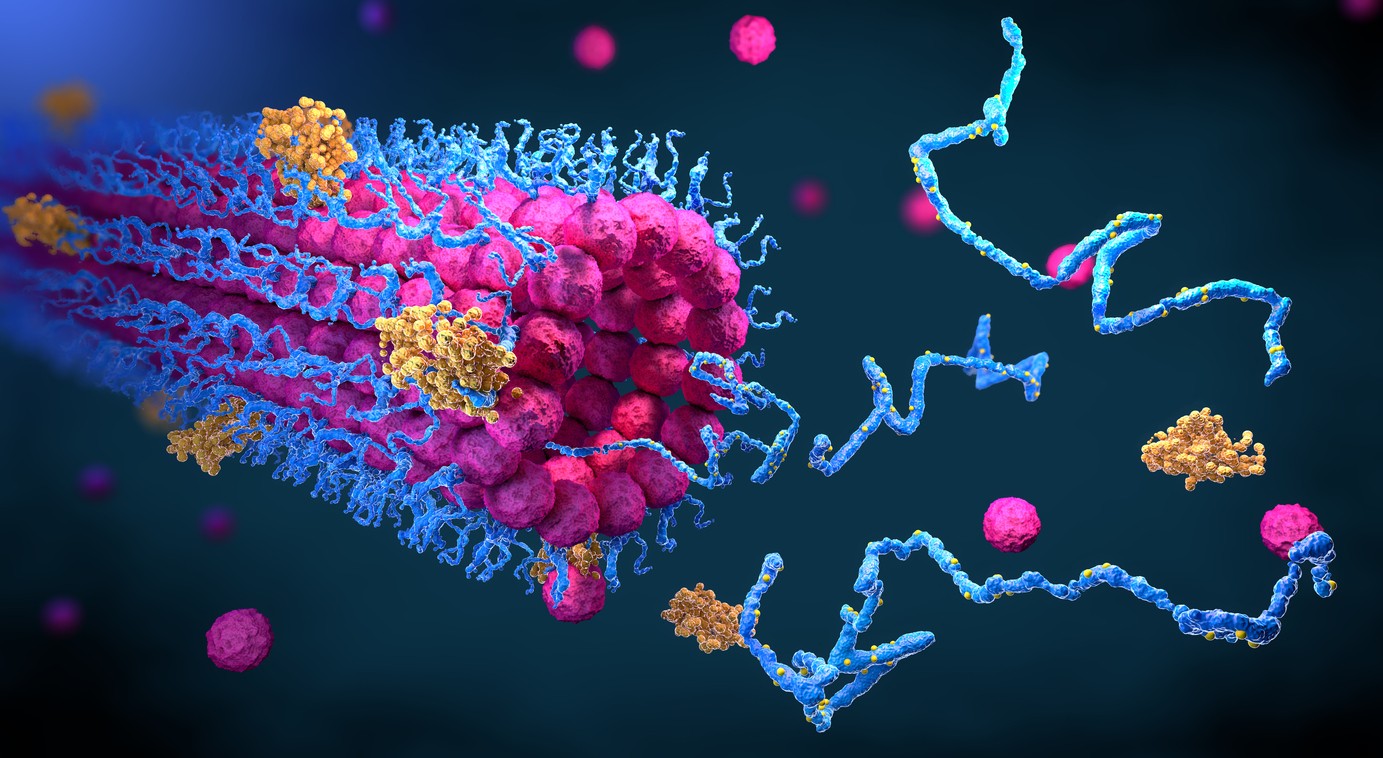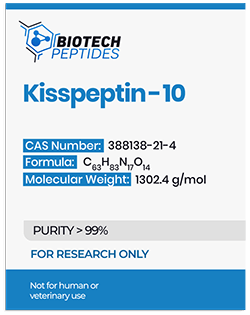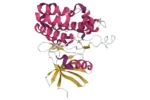The KISS1 gene has been identified as a potential suppressor of metastasis in melanomas and breast carcinomas. This may suggest potential impacts on the inhibition of abnormal cell proliferation.[1] Initially recognized for its potential in metastasis suppression, subsequent research proposed that Kisspeptin-10 may hypothetically impact the hypothalamus and pituitary gland. This may imply some impact on the regulation of systems related to reproduction. Independent studies conducted in the mid-2000s suggest it may be possible for Kisspeptin-10 to be involved in hypogonadotropic hypogonadism. This may be particularly true in its capacity as a ligand for the G-protein coupled receptor 54 (GPR54).[3]
Mechanism of Action
Hypogonadotropic hypogonadism is characterized by inadequate or absent sex hormone production. This may be due to dysfunction in the pituitary gland, hypothalamus, or other parts of the brain. Gonadotropin-releasing hormone (GnRH) is considered to play a pivotal role in stimulating the pituitary gland to release follicle-stimulating hormone (FSH) and luteinizing hormone (LH), both of which are integral to various reproductive functions. Deficiencies in GnRH, FSH, and LH are identified as key contributors to hypogonadotropic hypogonadism.[4]
The GPR54 receptor also referred to as the KISS1 receptor (KISS1R), has been identified as a critical GnRH receptor.[4] Kisspeptin-10 is hypothesized to bind to GPR54 receptors, which may potentially activate the reproductive axis through the stimulation of GnRH and gonadotropin neurons.[5]
Research has isolated smaller peptide fragments, such as Kisspeptin-10, Kisspeptin-13, and Kisspeptin-14, which may exhibit biological activity towards GPR54. These peptides are proposed to bind with low affinity to GPR54 receptors, which may induce calcium mobilization, arachidonic acid release, and extracellular protein kinase phosphorylation. Such events may eventually lead to the depolarization of Kisspeptin-10 neurons and may ultimately contribute to gonadotropin release.
Ongoing research has posited several potential mechanisms of action for Kisspeptin-10. This includes the peptide’s possible role in stimulating GnRH release. The peptide may support endogenous gonadotropin release in animal models with reduced fertility. Also, the peptide may induce desensitization and suppression of the hypothalamus-pituitary-gonadal axis under certain conditions.[6]
Scientific and Research Studies
Kisspeptin-10 Peptide and Delayed Hormonal Development
The primary aim of this referenced scientific study[7] was to investigate the observed impacts of Kisspeptin-10 peptide in research models with delayed hormonal development.
In this study, researchers hypothesized that Kisspeptin-10 may stimulate gonadal hormone release and modulate reproductive function in laboratory test models. The study involved the random introduction of either Kisspeptin-10 or gonadotropin-releasing hormone (GnRH) to the test models.
Luteinizing hormone (LH) levels were monitored overnight following the introduction. Subsequently, all test models were exposed to GnRH for six days, after which LH levels were re-evaluated. The results observed by researchers indicated that 47% of the experimental group exposed to Kisspeptin-10 exhibited increased LH levels. An additional 6% of the group exhibited an intermediate response, while the remaining 47% indicated no change after exposure to the peptide.
Kisspeptin-10 Peptide and Reproductive Regulation
A comprehensive literature review conducted in 2017 examined articles published between 1999 and 2016. This review suggested that experimental data might support the hypothesis that the Kisspeptin-10 system—including the KISS1 gene and its associated GPR54 receptors—might potentially regulate the release of gonadotropin hormones. Researchers suggest that “Kisspeptin or its receptor represents a potential therapeutic target in… [test models] with fertility disorders.”[8]
Studies conducted on experimental animal models suggested that reproductive disorders like HH and PCOS might be linked to abnormalities within the KISS1 and GPR54 systems. The findings of this literature review indicated that Kisspeptin-10 may potentially function as a neuropeptide regulator of GnRH release.
Kisspeptin-10 Peptide and Reproductive Hormone Release
The objective of the study[9] was to explore the potential influence of Kisspeptin-10 on the secretion of reproductive hormones. Kisspeptin-10 was introduced to both male and female test models. The findings indicate that in male test models, exposure to the peptide may lead to an elevation in follicle-stimulating hormone (FSH) and luteinizing hormone (LH) levels. In contrast, female test models did not exhibit significant changes in FSH and LH levels throughout the menstrual cycle. Comparatively, there was a notable increase in the hormone levels of observed female test models during the preovulatory phase.
Kisspeptin-10 and Its Influence on Food Intake
Kisspeptin-10 appears to be widely distributed across various brain regions, including the hippocampus, cerebellum, posterior hypothalamus, and septum. Its presence in key nuclei involved in food intake regulation, such as the arcuate nucleus (Arc) within the hypothalamus, prompted an investigation into its potential impacts on the feeding behavior of murine test models.
An experiment[10] involving adult male murine models, aged 6 to 8 weeks and maintained under standard conditions, assessed the impact of Kisspeptin-10 on food intake. Following an overnight fast, the murine models were exposed to varying concentrations of Kisspeptin-10 or a placebo alongside a standard rodent diet and water.
Results from this study suggest that Kisspeptin-10 introduction in overnight-fasted mice led to a reduction in caloric intake during the initial 3-to-12-hour period. However, caloric intake reportedly increased during the subsequent 12-to-16-hour period, eventually aligning with levels observed in the placebo group of laboratory test models. This suggests that Kisspeptin-10 may “be a negative central regulator of feeding by increasing satiety.” Scientists observed that exposure to the peptide may lead to increased intervals between periods of calorie consumption without significant change to caloric intake.
Further research[11] has explored Kisspeptin-10’s potential impacts on caloric intake regulation within the central nervous system (CNS). Investigations have suggested that the peptide may influence the expression of genes associated with neuropeptide Y (NPY) and brain-derived neurotrophic factor (BDNF). Additionally, Kisspeptin-10 may affect neurotransmitter concentrations, including dopamine, norepinephrine, serotonin (5-hydroxytryptamine or 5-HT), dihydroxyphenylacetic acid, and 5-hydroxyindoleacetic acid in hypothalamic cells (specifically Hypo-E22 cells). Observations indicate that Kisspeptin-10 might support NPY gene expression while suppressing BDNF expression.
The peptide also appears to reduce serotonin and dopamine levels, with norepinephrine concentrations remaining stable. Notably, this reduction in dopamine and serotonin was accompanied by increased ratios of their metabolites—dihydroxyphenylacetic acid to dopamine and 5-hydroxyindoleacetic acid to serotonin—following Kisspeptin-10 exposure. The observed changes in NPY and BDNF expression, coupled with alterations in serotonin activity, may suggest a potential role for Kisspeptin-10 in influencing hunger hormone signaling.
Kisspeptin-10 and Emotional Impacts
The study aimed to investigate the impacts of Kisspeptin-10 on limbic brain activity.[12] Neuroimaging and psychometric assessments were employed to analyze the impact of Kisspeptin-10 exposure in research models. The findings suggest that Kisspeptin-10 may have influenced limbic brain function, with data suggesting heightened responsiveness to mating and bonding stimuli.
Kisspeptin-10 and Neuroprotection
The accumulation of amyloid-beta (Aβ) and alpha-synuclein (α-syn) in cholinergic neurons is associated with damage and dysfunction in critical central nervous system structures. It is hypothesized that Kisspeptin-10 may bind to extracellular Aβ, potentially mitigating its harmful impacts. Studies[13] indicate that Kisspeptin-10 may counteract the detrimental actions of Aβ, prion protein (PrP), and Islet Amyloid Polypeptide (IAPP) without interference from antagonists of the kisspeptin receptor (GPR-54) or the neuropeptide FF (NPFF) receptor. The similarity between the non-amyloid-β component (NAC) of α-syn and the C-terminus of Aβ raises the possibility that Kisspeptin-10 might also reduce α-syn-induced toxicity in cholinergic neurons.
Research[14] involving cholinergic cells suggests that while high concentrations of Kisspeptin-10 may increase toxicity, lower concentrations might decrease toxicity associated with both wild-type and E46K mutant forms of α-syn. Computational studies support these findings, and some suggest a potentially significant interaction between Kisspeptin-10 and the C-terminal residues of α-syn. Molecular dynamics simulations indicate that the complexes formed between Kisspeptin-10 and α-syn indicate substantial stability.
Further investigation[15] has focused on whether GPR54 activation is crucial for Kisspeptin-10’s ability to bind to the C-terminal regions of α-syn. One study observed choline acetyltransferase (ChAT)-positive SH-SY5Y neurons, genetically modified to express either wild-type or E46K mutant α-syn, to evaluate the impact of Kisspeptin-10 on neuronal damage through flow cytometry and immunocytochemistry.
Some findings suggest that Kisspeptin-10 may reduce both apoptosis and mitochondrial damage in neurons affected by α-syn, with its protective impacts remaining unaffected by the presence of a GPR54 antagonist, kisspeptin-234 (KP-234). This implies that GPR54 activation might not be necessary for Kisspeptin-10’s neuroprotective impacts. Additionally, Kisspeptin-10 appears to lower the levels of α-syn and ChAT in neurons overexpressing both wild-type and E46K mutant α-syn.
Disclaimer: The products mentioned are not intended for human or animal consumption. Research chemicals are intended solely for laboratory experimentation and/or in-vitro testing. Bodily introduction of any sort is strictly prohibited by law. All purchases are limited to licensed researchers and/or qualified professionals. All information shared in this article is for educational purposes only.
References:
- KISS1 KiSS-1 metastasis suppressor [Homo sapiens (humans)]. https://www.ncbi.nlm.nih.gov/gene/3814
- Mead EJ, Maguire JJ, Kuc RE, Davenport AP. Kisspeptins: a multifunctional peptide system with a role in reproduction, cancer, and the cardiovascular system. Br J Pharmacol. 2007 Aug;151(8):1143-53. doi: 10.1038/sj.bjp.0707295. Epub 2007 May 21. PMID: 17519946; PMCID: PMC2189831. https://www.ncbi.nlm.nih.gov/pmc/articles/PMC2189831/
- Messager S, Chatzidaki EE, Ma D, Hendrick AG, Zahn D, Dixon J, Thresher RR, Malinge I, Lomet D, Carlton MB, Colledge WH, Caraty A, Aparicio SA. Kisspeptin directly stimulates gonadotropin-releasing hormone release via G protein-coupled receptor 54. Proc Natl Acad Sci U S A. 2005 Feb 1;102(5):1761-6. doi: 10.1073/pnas.0409330102. Epub 2005 Jan 21. PMID: 15665093; PMCID: PMC545088. https://www.ncbi.nlm.nih.gov/pmc/articles/PMC545088/
- Hypogonadotropic hypogonadism. US National Library of Medicine. https://medlineplus.gov/ency/article/000390.htm
- Rønnekleiv OK, Kelly MJ. Kisspeptin excitation of GnRH neurons. Adv Exp Med Biol. 2013;784:113-31. doi: 10.1007/978-1-4614-6199-9_6. PMID: 23550004; PMCID: PMC4019505. target=”_blank” rel=”noopener”https://www.ncbi.nlm.nih.gov/pmc/articles/PMC4019505/
- Prague JK, Dhillo WS. Potential Clinical Use of Kisspeptin. Neuroendocrinology. 2015;102(3):238-45. doi: 10.1159/000439133. Epub 2015 Aug 7. PMID: 26277870. https://pubmed.ncbi.nlm.nih.gov/26277870/
- Kristen P. Tolson et al., Impaired kisspeptin signaling decreases metabolism and promotes glucose intolerance and obesity. The Journal of Clinical Investigation. Published June 17, 2014. https://www.jci.org/articles/view/71075
- Zeydabadi Nejad S, Ramezani Tehrani F, Zadeh-Vakili A. The Role of Kisspeptin in Female Reproduction. Int J Endocrinol Metab. 2017 Apr 22;15(3):e44337. doi: 10.5812/ijem.44337. PMID: 29201072; PMCID: PMC5702467. https://www.ncbi.nlm.nih.gov/pmc/articles/PMC5702467/
- Comninos AN, Wall MB, Demetriou L, Shah AJ, Clarke SA, Narayanaswamy S, Nesbitt A, Izzi-Engbeaya C, Prague JK, Abbara A, Ratnasabapathy R, Salem V, Nijher GM, Jayasena CN, Tanner M, Bassett P, Mehta A, Rabiner EA, Hönigsperger C, Silva MR, Brandtzaeg OK, Lundanes E, Wilson SR, Brown RC, Thomas SA, Bloom SR, Dhillo WS. Kisspeptin modulates sexual and emotional brain processing in humans. J Clin Invest. 2017 Feb 1;127(2):709-719. doi: 10.1172/JCI89519. Epub 2017 Jan 23. PMID: 28112678; PMCID: PMC5272173. https://www.ncbi.nlm.nih.gov/pmc/articles/PMC5272173/
- Stengel, A., Wang, L., Goebel-Stengel, M., & Taché, Y. (2011). Centrally injected kisspeptin reduces food intake by increasing meal intervals in mice. Neuroreport, 22(5), 253–257. https://www.ncbi.nlm.nih.gov/pmc/articles/PMC3063509/
- Orlando G, Leone S, Ferrante C, Chiavaroli A, Mollica A, Stefanucci A, Macedonio G, Dimmito MP, Leporini L, Menghini L, Brunetti L, Recinella L. s of Kisspeptin-10 on Hypothalamic Neuropeptides and Neurotransmitters Involved in Appetite Control. Molecules. 2018 Nov 24;23(12):3071. Doi: 10.3390/molecules23123071. PMID: 30477219; PMCID: PMC6321454. https://www.ncbi.nlm.nih.gov/pmc/articles/PMC6321454/
- Chan YM, Lippincott MF, Kusa TO, Seminara SB. Divergent responses to kisspeptin in children with delayed puberty. JCI Insight. 2018 Apr 19;3(8):e99109. doi: 10.1172/jci.insight.99109. PMID: 29669934; PMCID: PMC5931121. https://www.ncbi.nlm.nih.gov/pmc/articles/PMC5931121/
- Milton NG, Chilumuri A, Rocha-Ferreira E, Nercessian AN, Ashioti M. Kisspeptin prevention of amyloid-β peptide neurotoxicity in vitro. ACS Chem Neurosci. 2012 Sep 19;3(9):706-19. doi: 10.1021/cn300045d. Epub 2012 May 30. PMID: 23019497; PMCID: PMC3447396. https://pubmed.ncbi.nlm.nih.gov/23019497/
- Simon, C., Soga, T., Ahemad, N., Bhuvanendran, S., & Parhar, I. (2022). Kisspeptin-10 Rescues Cholinergic Differentiated SHSY-5Y Cells from α-Synuclein-Induced Toxicity In Vitro. International journal of molecular sciences, 23(9), 5193. https://doi.org/10.3390/ijms23095193
- Simon, C., Soga, T., & Parhar, I. (2023). Kisspeptin-10 Mitigates α-Synuclein-Mediated Mitochondrial Apoptosis in SH-SY5Y-Derived Neurons via a Kisspeptin Receptor-Independent Manner. International journal of molecular sciences, 24(7), 6056. https://doi.org/10.3390/ijms24076056
- Image Source: https://pubchem.ncbi.nlm.nih.gov/compound/Kisspeptin-10







